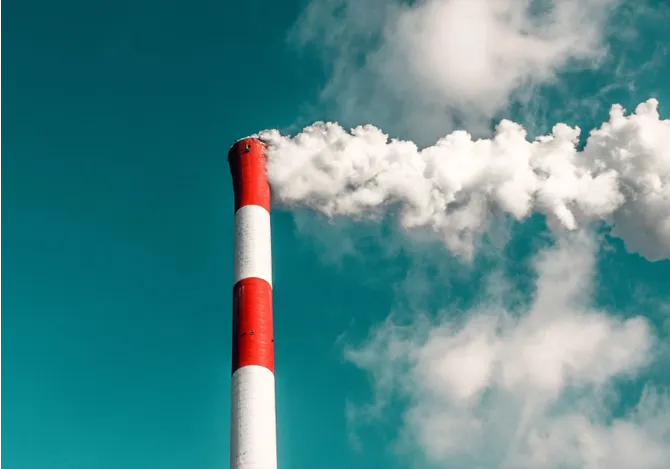
The Carbon Border Adjustment Mechanism (CBAM), a carbon levy on high-carbon products imported into the European Union (EU), is set to be implemented as a component of the European Green Deal in 2026. However, its initial reporting commences in 2023. This fiscal action is a component of the EU’s intensified action of its environmental goals, particularly in light of ‘carbon leakage’. The CBAM's gradual rollout coincides with the gradual elimination of free allowances in the EU Emissions Trading System (ETS), aiming to further the EU's industrial decarbonisation efforts. The price of the CBAM certificates, in the process, is linked to the price of EU-ETS. Hence, though CBAM is initially proposed for sectors like cement, iron and steel, aluminium, fertilisers, electricity and hydrogen, there are plans to expand its scope to include sectors like agriculture, textiles, electronics and IT, amongst others. which will encompass more than 50 percent of the emissions in ETS-covered sectors.
The CBAM's gradual rollout coincides with the gradual elimination of free allowances in the EU Emissions Trading System (ETS), aiming to further the EU's industrial decarbonisation efforts.
The EU considers the CBAM as the landmark instrument that will help discover fair prices on the emitted carbon that occurs as an externality of the production of carbon-intensive goods entering their territories. The EU envisages this as an “encouragement” to the producing non-EU economies to shift to cleaner production practices. To ensure that the carbon cost of the imports matches with that of the EU's domestic production, the CBAM verifies that costs are covered for the carbon emissions embedded in the production of specific goods imported into the EU. This helps safeguard the EU’s climate goals. Additionally, the CBAM is structured to align with the rules of the World Trade Organization (WTO).
Given the above, we raise questions against CBAM from the perspective of just transition and argue how the process and instrument are antithetical to the avowed cause. Humanity is currently facing the consequences of its penchant for unbridled economic growth, without considering the associated “costs of growth.” This oversight has manifested in the form of the devil incarnate—climate change. Globally, there is a consensus on the need to forge new development pathways that emphasise sustainability and a net-zero future to prevent a disaster. This transition must be swift yet equitable and inclusive. This is particularly crucial for the Global South, which has borne the brunt of the industrialisation of the Global North. More so because the large parts of the Global South who are bearing the cost of industrialisation of the Global North also have their aspirations—they may not have the wherewithal or bandwidth to make this transition without incurring huge economic costs in the forms of sacrificing growth, employment and economic well-being. The question is: who will bear this cost?
Humanity is currently facing the consequences of its penchant for unbridled economic growth, without considering the associated “costs of growth.”
The concept of just transition is a forward-thinking, unifying approach grounded in principles, processes, and practices aimed at transforming our economy from an exploitative model to a regenerative one. This involves rethinking production and consumption to be more holistic and waste-free. On the other hand, just transition also needs to entail North-South transfers to meet their needs, as the transition to a green economy for large parts of the Global South will necessitate a compromise with their present ambitions and aspirations for the actions of not theirs, but somebody else’s! In that sense, it is only just that the polluter, i.e., the industrialised nations of the Global North bear the cost of this transition for the South.
Grounds of departure
One needs to keep in mind that many nations in the Global South may have carbon-intensive production processes, and their transition to a green economy will not happen by 2026. Even today, the per capita carbon emissions of the United States (US) (13.68 tons), Canada (14.43 tons), Australia (15.22 tons) and EU (5.5 tons) are way higher than South Asian nations like India (1.6), Bangladesh/ Nepal (0.5), Myanmar (0.6), etc. Therefore, the marginal rate of emission per capita (extra unit of emission due to an extra unit of production per capita) is lower in these nations as compared to most nations in the North including the EU. This has also been exhibited in one of the recent Observer Research Foundation (ORF) research that shows that BRICS (or the emerging nations’ bloc) performs best among various blocs like G20 and OECD regarding climate performance. Furthermore, India performs the best among the BRICS nations. Another ORF paper reveals that India has the lowest carbon cost of growth (or emission associated with an extra unit of GDP growth) among the G20 nations.
Even then, nations of South Asia that are yet to move towards low carbon-intensity industrial production will be compared with those of the Global North and will be penalised under the CBAM scheme which will make their products less competitive in the EU market. This will go against the principle of just transition. On the other hand, the EU nations are also responsible for providing green finance (mitigation, adaptation, and loss and damage), but will penalise Bangladesh's textiles and Ready-Made Garments (RMG) industry that forms a significant component of their export basket and has been their critical growth driver. The concerns in the textile industry are already palpable as if CBAM is put to effect on textiles, the competitiveness of the smaller economies might be at stake. Therefore, CBAM and development and climate financing from the EU, when looked together, is tantamount to paying the Global South and then robbing them.
The EU nations are also responsible for providing green finance (mitigation, adaptation, and loss and damage), but will penalise Bangladesh's textiles and Ready-Made Garments (RMG) industry that forms a significant component of their export basket and has been their critical growth driver.
The inequity can also be understood from the fact that by bringing CBAM to effect, the EU is forcing the developing nations to achieve much more than their commitments under the Paris Agreement. As per the Paris Agreement, various nations have committed to their Nationally Determined Contributions (NDCs)—a climate action plan for mitigation and adaptation—as per their capabilities and levels of development. As an example, India has committed to reducing the emission intensity of its GDP by 45 percent by 2030 over 2005 figures. However, India hasn't committed to reducing carbon emissions to EU levels in the sectors included under CBAM. This action by the EU is tantamount to arm-twisting the developing world to comply with their set standards for atonement of the folly that the EU have historically committed. Committing a folly and passing on a share of the atonement to the affected is far from being just or equitable—the principles on which the COP negotiations are based.
The question of the market-based valuation
The other problem is with the market-based valuation of the CBAM. This valuation is being done by the EU-ETS prices. In no way, did the market discover the value of carbon arresting (whether by stocking or by sequestration). The goal with which carbon markets were set up was to reduce carbon emissions, and not to emerge as a hub of speculation. These markets, by discovering the carbon credit prices, were supposed to reflect on the value of carbon absorption, sequestration, and stocking. This value is aptly captured by the Social Cost of Carbon (SCC), as conceptualised by William Nordhaus, (although introduced in the Stern Review) as the cost that the society bears with an additional unit of carbon emission.
However, market efficiency in accurately incorporating all relevant information into prices and making prices gravitate towards value is questionable. George Akerlof's 1970 study on adverse selection highlighted how incomplete information leads to market inefficiencies thereby making prices deviate from their intrinsic values. This issue is particularly acute in environmental markets, where there's a significant knowledge gap regarding the full range of ecosystem services and their impact. Consequently, carbon market prices often don't accurately reflect the true scarcity or social cost of carbon emissions.
The goal with which carbon markets were set up was to reduce carbon emissions, and not to emerge as a hub of speculation.
The Certified Emission Reduction (CER) market exemplifies this disconnect. Post-2012, CER prices fell due to decreased industrial activity. Did that mean that the value of carbon sequestration by mangrove forests has declined? Definitely not! This situation demonstrates that nature operates independently of economic systems, continually providing ecosystem services like climate control and nutrient cycling, regardless of market prices. As a result, there's a disconnect between the actual value of these services and their market prices. Environmental market prices, often demand-driven due to inelastic supply, are based on a limited understanding of the utility of these resources or services, leading to a misalignment between true ecological value and market valuation. In that sense, CBAM prices, being based on the EU-ETS system, are not a reflection of the scarcity value.
On grounds of equity and efficiency
Therefore, the moot point that this essay intends to highlight is that CBAM is neither based on equity principles (given that it is iniquitous due to its deviation from the principles of just transition); nor does it conform with efficiency criteria (due to inefficient markets) that will help the cause of sustainability and distributive justice. Therefore, when looked through the lens of Sustainomics that talks of reconciling the irreconcilable trinity of equity, efficiency and sustainability, CBAM falls flat on its face.
Nilanjan Ghosh is a Director at the Observer Research Foundation
Ajay Tyagi is a Distinguished Fellow at the Observer Research Foundation
The views expressed above belong to the author(s). ORF research and analyses now available on Telegram! Click here to access our curated content — blogs, longforms and interviews.




 PREV
PREV



